Explore the best flavors of the Alentejo: what and where to eat in Lisbon
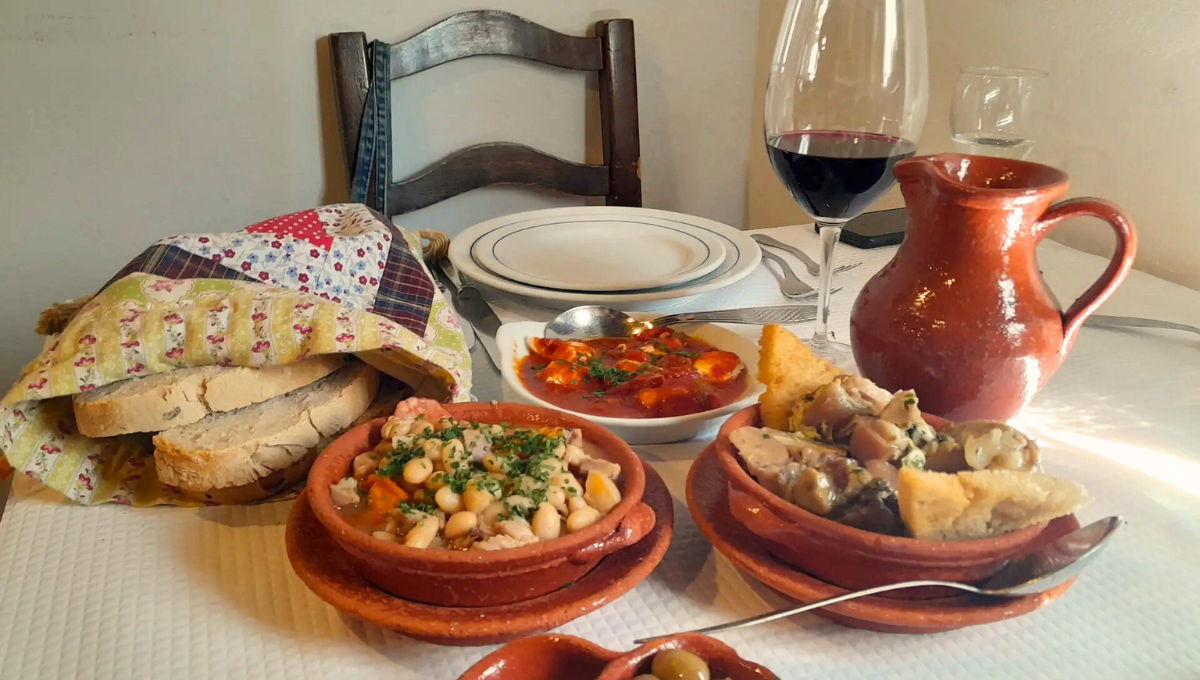
Sandwiched between the very popular Lisbon and Algarve regions, Alentejo might go unnoticed by many foreign visitors. However, this southern region has real charm to it. Its diverse geography ranges from open fields to rugged mountains and breathtaking ocean views. The Baixo Alentejo region is known for its vast, flat plains, and a rural landscape that is characterized by earthy colors and vast open skies. To the north, Alto Alentejo is marked by rolling hills and mountainous terrain, offering scenic views and a more rugged atmosphere. Finally its coast, stretching along the Atlantic Ocean, contrasts with the inland landscape, offering beautiful, unspoiled beaches, dramatic cliffs, and serene coves, where watching the sun set over the Atlantic ocean is an unforgettable experience.
Historically a poorer and less populous region than its neighbors, with agriculture and livestock farming as its main economic activities, Alentejo is to this day known for its calm and slow pace of life, where people take their time and generally have a more leisurely approach to life. In fact, many Lisboners choose Alentejo as a place to relax and get away from the rush of city life, taking advantage of the beautiful landscapes, stunning beaches and delicious food of this region.
Feat photo by Expresso
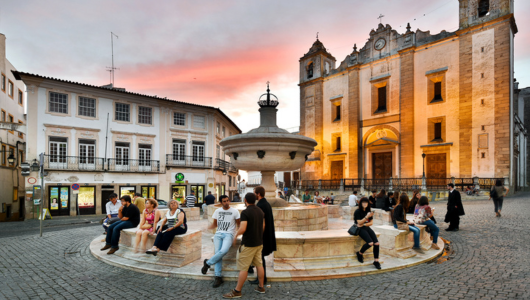 Photo by Rick Steves Europe
Photo by Rick Steves Europe
There are certainly many reasons to visit this part of the country, and although not everyone who visits the Portuguese capital will be able to enjoy all that Alentejo has to offer, there are still some places that are perfect to visit on a day-trip from Lisbon, like Évora, for example. And if you are interested in checking out the restaurant scene in the region, you’ll find that there are restaurants outside Lisbon that are definitely worth the journey.
However, even if you can’t travel to Alentejo, Alentejo can travel to you. Throughout time, many alentejanos have migrated to the busier capital, looking for jobs and a better life, and with them they brought their love for their cuisine, which now is considered by many to be one of the most iconic regional cuisines of Portugal. Let’s find out a bit more about what characterizes the food from Alentejo, its most representative and unmissable dishes and, most importantly, where you can enjoy them without leaving Lisbon itself.
The typical flavors of Alentejo
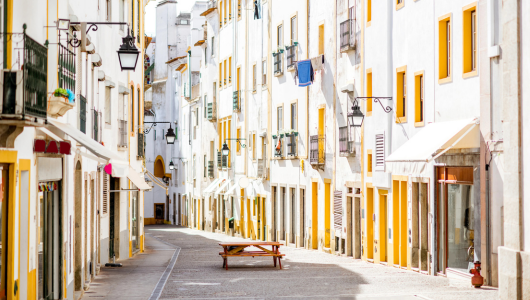 Photo by Condé Nast Traveller India
Photo by Condé Nast Traveller India
The cuisine of Alentejo reflects its history and struggles, as well as the resourcefulness and resilience of its people. Much like Italy’s cucina povera, Alentejan cooking relies on humble, locally sourced ingredients – fragrant garlic, delicious and hearty bread, olive oil, and a variety of fresh herbs such as coriander, mint, oregano, and poejo, a wild mint-like plant known in English as pennyroyal. These ingredients, though simple, form the backbone of the region’s flavorful dishes.
Foraging also plays a significant role in this region’s cuisine, with wild greens and herbs adding richness and fragrance to what might at first seem simple traditional meals. Dishes like purslane soup (sopa de beldroegas) and scrambled eggs with asparagus (ovos com espargos) are traditionally made with foraged ingredients (in this case, the purslane and the wild asparagus) and demand not only a connection to the land, but also a respect for ideas of seasonality.
 Photo by BePortugal
Photo by BePortugal
However, in Alentejo, the simplicity of ingredients doesn’t just reflect scarcity; the ingredients themselves are celebrated and revered. Famous in all of Portugal, the regional bread, commonly known as pão Alentejano, is characterized by its thick, crusty exterior, as well as a dense yet moist interior, marked by air pockets, and its rustic appearance. With minimal ingredients – salt, water and wheat flour – it extracts its full and slightly tangy flavour from the slower fermentation process it goes through. All of these characteristics make pão Alentejano the perfect ingredient for the recipes of Alentejo, where it can be fried, or used in broths and soups, lending them a delicious heartiness.
The Portuguese take their cheeses very seriously, and when it comes to this matter, this region is no different. Famous throughout the country, the cheeses of Alentejo are known for its robustness, as well as their bold flavors. Made from sheep, cow or even goat milk, they are usually semi-soft to hard (depending on the type of cheese) and often have a longish aging process. Among the most famous are queijo de Serpa, a semi-soft sheep’s milk cheese known for its smooth, creamy texture and slightly tangy, salty flavor; queijo de Nisa, a hard, sheep’s milk cheese from the Nisa region, with a firm texture and a more pronounced, nutty flavor when aged, typically dry and crumbly with a sharp, savory taste; and queijo de Evora, a semi-soft cheese, made from sheep’s milk, characterized by a smooth, slightly crumbly texture as well as a mild, creamy flavor with a slight tang.
 Photo by Trendy
Photo by Trendy
Although many might consider Alentejan cuisine as the most vegetarian friendly of all Portuguese regional cuisines, it does make use of animal products, and when it comes to this matter, pork is most definitely the most popular animal protein to consume. Pork is central to Alentejan cuisine due to the region’s long history of pig farming, dating back to Roman times. Traditionally, the animals raised in this region are the acorn-fed Iberian black pigs (porco preto) which graze in the montado, which is a traditional agroforestry system of cork oak forests. In the montado, pigs roam freely, foraging on acorns and wild herbs, which impart the meat with a richer flavor, as well as a better distribution of fat and lean meat. The montado system is also linked to a more sustainable way of raising animals because it promotes biodiversity, prevents overgrazing, and allows natural regeneration of the land. The popularity of pork meat in Alentejo is also linked to its versatility (not only alentejanos but all portuguese traditionally will use it, nose to tail) as well as its ability to be preserved through curing, making it a reliable source of protein year-round.
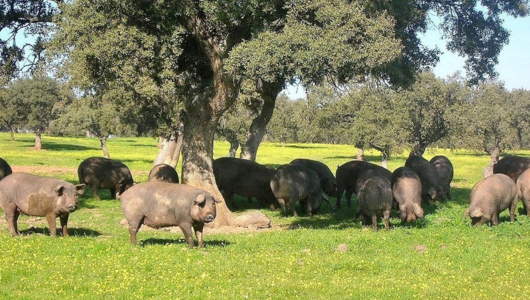 Photo by Porco Preto Alentejano
Photo by Porco Preto Alentejano
As is the case with cheeses, cured meats and sausages are a staple in Portugal. In the case of Alentejo, Iberian black pork is again the star of the show. The presunto de porco preto, like its cousin the Spanish Ibérico ham, is a dry-cured ham made from the prized Iberian black pigs. Cured over several months, it develops a rich, nutty flavor and delicate texture, making it a regional delicacy, and probably one of the most celebrated of all Portuguese cured meats. However, there are other cured meaty indulgences to celebrate in the region, like the delicious paio. This is a sausage crafted from lean pork loin, seasoned with garlic, salt, and is wrapped inside a pig’s stomach, to be first boiled and afterwards air-dried. It is often enjoyed sliced as a snack or appetizer, since it is made from more delicate (and expensive) cuts of meat. Finally, cacholeira, a sausage from Montalegre, is a more rustic offering when compared to paio,since it is a soft sausage made from pork liver and fat, seasoned with spices like garlic and cumin. Its bold, earthy flavor comes as much from its seasonings as from the meat of the porco preto.
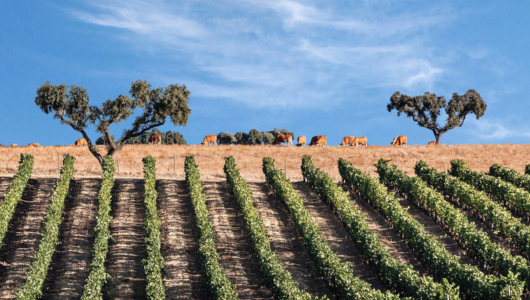 Photo by SevenFifty Daily
Photo by SevenFifty Daily
Finally, one could not write about food from Alentejo without mentioning its wine. It is most definitely one of the most popular wine regions in Portugal, and one of the most varied, given its geographic and meteorologically diverse characteristics. As with other Portuguese regions, the wine in Alentejo is marked by the presence of local grape varieties. Popular red grapes include Alicante Bouschet, Aragonês (known as Tempranillo in Spain), and Trincadeira. For whites, Antão Vaz stands out, alongside Arinto and Roupeiro. All of this variety of grapes and wine profiles will definitely guarantee that with any good dish from Alentejo, you’ll always find an Alentejo wine to pair it with.
Must try dishes from Alentejo
It is hard to select what to showcase as dishes that you shouldn’t miss out on, and there’s always some that won’t make it here, even though they more than deserve it. Also, since seasonality is so important in this cuisine, it might be difficult to find some dishes all year around. In Alentejo people usually won’t eat gaspacho during the cold months, and ingredients like wild asparagus and purslane usually can be foraged only during the spring months or even in the early Fall. Some dishes might also be more challenging to find in Lisbon due to its ultra regional character, or its use of more unusual ingredients, that are not enjoyed by many people nowadays. Regardless of the limitations one might have when searching for Alentejan food in Lisbon, it is worth it to keep an open mind, be flexible and enjoy the offers that will surely still be very varied. And if in a restaurant they recommend a dish that is not on this list, give it a try too. There’s most certainly no shortage of deliciousness to go around when it comes to traditional recipes from the Alentejo!
Petiscos | Alentejo’s appetizers
If there is a region that seems to take the art of the petiscos seriously, it is Alentejo. Petiscos are not only snacks, or small dishes. They are food made to be shared, and to be eaten leisurely ideally with a good glass of wine or even a beer, so one can see how they fit perfectly with the relaxed culture of Alentejo.
Alentejan petiscos vary immensely. From the simple to the more elaborate, from meat-free dishes to extremely meat heavy ones, there is definitely something for everyone. Obviously, the cured meats and cheeses mentioned previously, as well as the delicious regional bread are unavoidable when we talk about Alentejo’s snacky delights, as well as the tasty local olives, often seasoned with garlic and oregano, for a more southern Portuguese flavor.
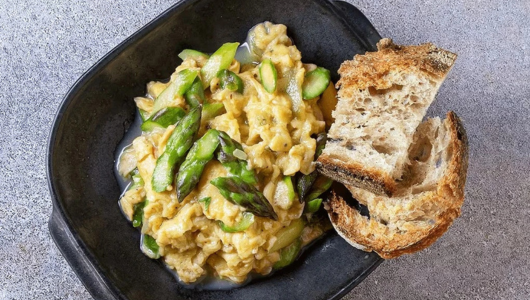 Photo by Cozinha Tradicional
Photo by Cozinha Tradicional
One of the most iconic petiscos might be the deceptively simple scrambled eggs and asparagus (ovos com espargos), which traditionally is made with wild asparagus, foraged in the spring. Its simplicity and reliance on local, seasonal and foraged ingredients perfectly encapsulates the spirit of Alentejo’s cuisine.
 Photo by Receitas Para Todos os Gostos
Photo by Receitas Para Todos os Gostos
Although some of these snacks might be harder to find in Lisbon, the small but mighty chicken pie (empada de galinha) has gained such popularity that you might be able to find it in most of the capital’s pastry shops (pastelarias). Often eaten as quick snacks, one might be forgiven for forgetting how time consuming and labor intensive these are, involving boiling a whole chicken seasoned with onion, bacon, cloves, black pepper, salt and vinegar, then breaking it down and pan frying it with the bacon in cubes, then filling puff pastry cases with the mixture in order to obtain a delightful hand pie that is perfect for when you are craving a little something between meals.
 Photo by Evasões
Photo by Evasões
Although there are plenty of petiscos that are beginner friendly, some of the most special delicacies might involve being open minded and willing to try out something a bit different. The humble history of this region has taught its people to be resourceful, and, therefore, to use all the parts of the animals they slaughtered. With time, what was born of necessity became a beloved treasure. Among some of these more Portuguese bizarre foods are pézinhos de coentrada (pictured here), which consists of pig’s feet cut in small pieces, boiled and pan fried with olive oil, garlic, onion, cilantro, clove, and a few chillies; salada de orelha, a cold salad of boiled and chopped pig’s ear, seasoned with diced raw onion, garlic, olive oil, vinegar, and cilantro; or cabeça de xara, also known as queijo de cabeça de porco, that is, pig’s head cheese. This last dish is particularly interesting, not only due to its characteristics, but also to its origin, which some think might be French (from the dish tête d’achard), and others believe might be Arab. It is made by boiling the whole head of a pig with wine, water, vinegar and plenty of herbs, until the meat falls from the bones, and then removing all bones, leaving meat, skin, fat and cartilage, which is chopped, and pressed into the shape of a cheese, with the help of a cloth, twine and a weight, for at least 24h. The result is an intense and rich petisco that begs for some bread and wine to go with it.
 Photo by Montra Alentejana
Photo by Montra Alentejana
Finally, perhaps one of the most challenging dishes, and maybe harder to find, is túbaros, or testicles (here pictured raw). Indeed, that part of the animal anatomy is also consumed, because in Alentejo, nose to tail eating really means every part of the animal. Although one can use bull or even lamb’s testicles, the most common in the region are pig’s testis. Despite preconceived ideas about the texture of this dish, the method of cooking them – by boiling, removing the skin, cutting in pieces and then frying in olive oil, or more traditionally, lard – ensures a firm and slightly chewy texture, with the gaminess tamed by the marinade it goes through. If you manage to find this elusive delicacy, which nowadays often can only be found in Alentejo, and by ordering it in advance, definitely don’t miss out on it.
Gaspacho Alentejano | Alentejo’s cold soup
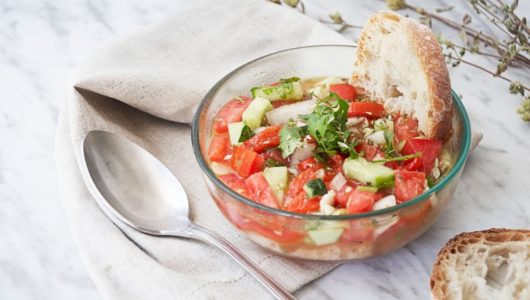 Photo by Ruralea
Photo by Ruralea
Unlike its more famous Andalusian counterpart, which relies on a blended base of ripe tomatoes, cucumbers, green peppers, garlic, olive oil, vinegar, and bread, resulting in a silky, drinkable soup, the gaspacho Alentejano is a more rustic and bread-centric dish. Diced tomatoes, cucumbers, green peppers, smashed garlic, and herbs like oregano are mixed with water (with ice cubes often added for an extra cooling freshness), olive oil, vinegar, and salt. Crusty Alentejan bread, often slightly stale, is added directly to the soup, soaking up the liquid. With its ice cold garlicky broth and zingy vinegary flavour, it is especially delicious in the scorching Summer days of Alentejo, at the same time that it proves once again how expertly this regional cuisine makes use of simple, good quality ingredients to make delicious food.
Tomatada | Tomato stew from the Alentejo
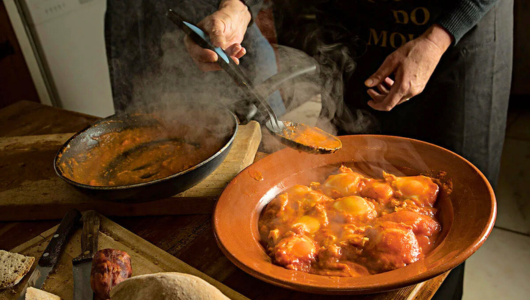 Photo by Saveur
Photo by Saveur
Another humble, simple to prepare, and meat free recipe that still manages to pack an enormous amount of flavor and umami is the delightful tomatada. At its core, tomatada is a rich tomato stew, prepared with very ripe seasonal tomatoes, garlic, onions, and olive oil, all slowly simmered to create a comforting sauce. Eggs are often poached directly in the tomato mixture, adding a creamy richness that pairs beautifully with the tangy and slightly sweet tomatoes. Some variations include adding Portuguese smoked sausage (chouriço) or bacon for extra depth of flavor and a salty kick, but the dish remains delicious even in its simplest form. Tomatada, which we could say is Portugal’s answer to shakshouka, is typically served with thick slices of Alentejan bread, which is perfect for soaking up the sauce, although in more recent years it has also been known to be served with french fries, which make the dish more filling, and turn it into a proper main meal. However, whether you’re dunking bread or fries in this tomatoey goodness, the experience will definitely be worth it.
Sopa de beldroegas | purslane soup
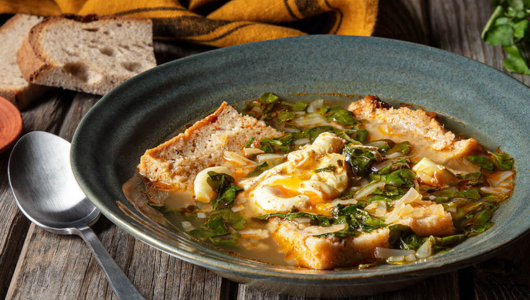 Photo by Ruralea
Photo by Ruralea
The beldroega, or purslane, is another green that is obtained through foraging, which makes this dish another seasonal delicacy, and the first of a few fragrant soups on our list. Although it is named after the vegetable, this soup is commonly also made with cheese (which can be soft fresh cheese, soft sheep’s cheese or even hard cheese) and sliced potato, and the beldroega (which is a seasonal ingredient, that grows spontaneously, often around vegetable gardens) can be swapped for spinach, or even lettuce. Once again we are presented with a dish that demonstrates the adaptability of Alentejanos, who typically state that “in Alentejo, you can make a soup with any herb” (“No Alentejo, com qualquer erva se faz uma sopa”). Indeed!
Sopa de cação | dogfish shark soup
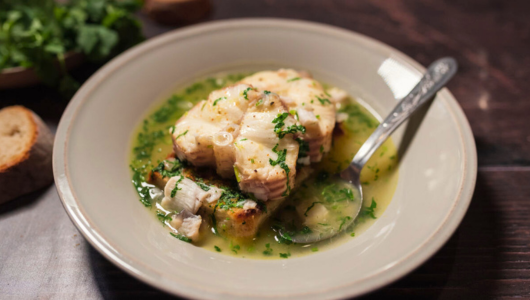 Photo by 24Kitchen
Photo by 24Kitchen
Perhaps the most famous of all fish based dishes in Alentejo, this aromatic soup is made with dogfish (cação), a type of firm, white-fleshed shark, which is first marinated in water, vinegar, salt and bay leaf for a couple of hours to tenderize the fish bones and preserve the qualities of the meat. The fish is then gently poached in a flavorful broth seasoned with garlic, coriander, bay leaves, olive oil and, sometimes, paprika. The soup is then thickened with a bit of flour dissolved in vinegar, which also imparts a characteristic Alentejo zing to it. Like many soups from this region, it is served on a bed of pão Alentejano, whose presence lends this soup a heartiness that most definitely turns it into a filling and robust main dish.
Açorda à Alentejana | Alentejo style bread stew
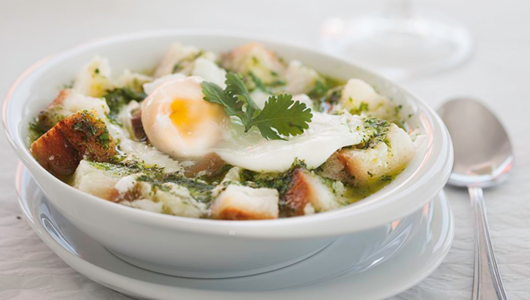 Photo by Visit Portugal
Photo by Visit Portugal
If one had to think of a quintessential dish from this region, it would be the açorda à Alentejana. Humble, customisable yet pared down, and focused on the main ingredients of this regional cuisine (bread, garlic, olive oil and herbs), the açorda Alentejana is, basically, Alentejo on a plate.
However, to understand this dish one must first understand what is an açorda. This method of cooking (and using up old bread, in the process) was brought to the Iberian Peninsula by the Arabs, who called it “ath thurda” or “ath thorda” in the local Andalusian Arab dialect, and which means “shredded and soaked bread”. This very general definition of açorda gained in Alentejo a much more narrow definition, since in the region it is characterised as a hot and clear broth with a base of garlic crushed with salt and olive oil, and scented with herbs, that is poured over bread. The herbs used can change, with cilantro and pennyroyal being the most popular, and the broth can be enriched using poached eggs, boiled or fried fish, or even salted cod.
We can now see how some of the previously mentioned soups, like sopa de cação, or sopa de beldroegas could also be considered an açorda. On the other hand, what for many people in Alentejo would not be view as one is the seafood açorda (açorda de marisco) or shrimp açorda (açorda de camarão) which can be commonly found in many restaurants in Lisbon, have very little broth and a lot more bread, and are thickened with egg yolks, giving them the texture not so much of a soup, but more of a thick and delicious porridge. In fact, many people in Alentejo would call this dish migas de camarão instead, for its consistency and potent flavour. So, if you happen to come across an açorda dish while in the capital, take these differences into account, because you might be looking for one delicious dish and getting another different, albeit also delicious one.
Migas | bread stuffing
 Photo by Michelin Guide
Photo by Michelin Guide
More than a recipe, migas are more of a type of dish, a cousin of the açorda, which shares its Arab origin. Both involve the use of stale bread, in a demonstration of frugality and resourcefulness, but while the açorda is a brothy affair, in the migas the bread is soaked in water, but has a much thicker consistency, turning into more of a paste, often fried in olive oil or pork fat. One may then see why Alentejans will look at the naming of Lisbon’s açorda de marisco with confusion and sometimes, even with annoyance.
One of the most famous migas recipe brings back an old foraged friend, the asparagus: migas com espargos. The wild green asparagus are boiled and added to the migas which are usually made using up the leftover fat and seasonings of pork meat that was previously pan fried. The migas should be cooked until a delicious crust forms around them, and they are served with the pan fried meat. There are of course different variations on this dish, some evolving eggs or even pig’s brains, and they can be made even more simply, with olive oil instead of pork fat.
Another perhaps heavier but probably more common version of this dish is the migas com entrecosto, similar in preparation to the previous version, but more meat-centric. Here, short ribs marinated overnight in red pepper paste and garlic, are fried, with its subsequent fat (called pingo) used to make the migas themselves. While cooking them, as they develop a crust, they can be rolled over themselves into an omelet-like shape, crispy on the outside and unctuous on the inside. The risk of making greasy migas is high, so an expert hand is needed to ensure they come out just right. In restaurants they are sometimes served with slices of orange, which brings an added freshness to this dish, pairing perfectly with the short ribs.
A dish of migas that never fails to invoke nostalgia in the hearts of the natives of Alentejo is migas de batata. In this dish the bread is replaced with boiled potatoes (that were often leftovers from other meals) crushed or pureed, and mixed with the “pingo, in the same way as other versions of migas. Migas de batata aren’t as easy to find outside of Alentejo as other dishes, so if you come across them, definitely give them a try.
Finally, even though migas can be made with various ingredients, different cuts of meat or even fish and egg, they can be as basic (and yet tasty) as the naturally plant based migas gatas. Bread, water, garlic and olive oil is all you need to make these, and if you add some herbs like cilantro or pennyroyal, you can create an even tastier delight. Whether you try a meat heavy and more complex recipe, or a lighter and simple version, do give this unmissable icon of Alentejo’s cuisine a try.
Carne de porco à Alentejana | Alentejo style fried pork with clams
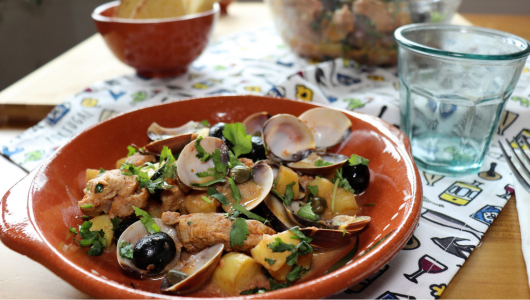 Photo by Cozinha Com Rosto
Photo by Cozinha Com Rosto
This well known regional dish is not only a local hit, but with time has become one of Portugal’s most iconic dishes, due to its addictive flavour, where intensively flavored cubes of pork are marinated in a mixture of garlic, paprika, white wine, bay leaves, and olive oil, which give it a rich and smoky flavor, and are afterwards combined with clams, which are cooked in the same pot, infusing the dish with a briny depth. The final touch is fresh cilantro, which adds brightness to the rich flavors. The fact that it is often served with perfectly golden cubed fried potatoes makes it an incredibly moreish dish, and Portugal’s most iconic surf-and-turf experience.
Ensopado de borrego | Alentejo lamb and bread stew
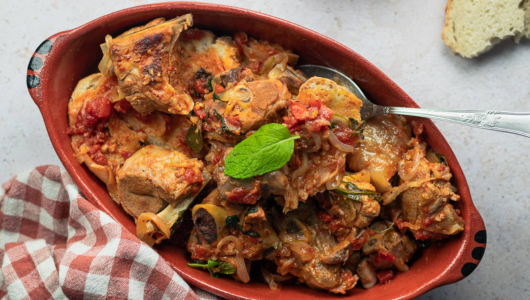 Photo by Continente
Photo by Continente
Eaten usually on Easter, in weddings and other big celebrations, this dish was one you’d definitely only eat on important days, as it is made with lamb meat, marinated for hours in a mixture of wine, garlic, bayleaf, paprika and black pepper, to tenderize the meat and remove some of its characteristic funkiness (curiously, a smell which in Portuguese has its own word – bedum). The meat is then browned in olive oil and stewed in its own marinade, with a hit of vinegar added at the end, that adds a very Alentejan brightness to the dish. Many variations of this dish also include mint in the stew, which also gives it a delightful herbaceous brightness. Finally, as we are talking about food from the Alentejo, at the end of the day, the meat is served on a bed of bread, and accompanied with boiled potatoes, whose creaminess perfectly balances out the robust flavours of the marinated meat.
Sweet treats from Alentejo
 Photo by Atrian
Photo by Atrian
Like in the rest of the country, desserts and pastries in Alentejo tend to be heavy on the egg yolks, since many of these sweet delights originated in convents, where nuns had plenty of egg yolks left over, after using the egg whites to starch their habits, which created a business opportunity that would literally shape Portuguese patisserie. One particular, and quite interesting take on this convent tradition is the pão de Rala (pictured above), or Rala bread, so called because it resembles a rustic loaf of bread. Its outer shell is a paste made from a mixture of almond flour, sugar, egg yolks and water, that is then stretched and stuffed with fios de ovos (sweet strands of sweet egg yolk that are made by delicately pouring egg yolk in a boiling sugar syrup) and doce de gila (a very traditionally Alentejan jam, made from the flesh of the gila, or fig-leaf gourd, which is cooked with sugar and flavored with cinnamon and lemon, resulting in a textured, fragrant jam). This sugar bomb of a dessert, whose first mentions in writing come from the 18th century, but that is most likely older than that, must definitely be eaten in moderation, but it will surely satisfy the sweetest of teeth.
Another and interestingly named offering out of the convents of the region is the toucinho do céu, that literally translates as “bacon from heaven”. Although it may contain lard instead of butter in its list of ingredients, there’s no actual bacon in this egg-heavy, dense and potent dessert. Instead, its main ingredients are almond flour, egg yolks and sugar, and it is flavored with cinnamon and clove. This heavenly mixture is then cooked in the oven and served covered in powdered sugar, ready to be enjoyed.
 Photo by VortexMag
Photo by VortexMag
Despite the popularity of convent sweets, there are in Alentejo a few desserts with even more interesting origins. Said to have been brought from the east by D. Constantino de Bragança that in the 16th century ruled the Portuguese territories in India, the iconic sericaia might be the first dessert most people think about, when they think about Alentejo’s sweet treats. Indispensable in festive occasions, this dessert is somewhat lighter than the previous ones due to the presence of egg whites, which are folded into an egg yolk, sugar, milk and flour mixture, flavored with cinnamon, and the very Portuguese lemon peel, as the Portuguese do love a citrusy flavour in their sweets. The mixture is then poured into clay deep dishes, and cooked in a super hot oven, so that it develops its characteristic “cracked” look. Finally, it must be served with another regional delicacy, the ameixa de Elvas, an extremely sweet local plum of the Regina Claudia type, obtained due to the very high temperatures that the region hits in the Summer. Although it can be eaten fresh, it is often dried and preserved in syrup, and it is this last version that traditionally will accompany the sericaia, giving it a contrasting flavor and texture that really elevates this celebrated dessert.
The iconic preserved ameixa de Elvas also traditionally accompanies another dessert from Alentejo, which in this case originates in the Santa Clara Convent, in Portalegre: the manjar branco, or white delight. This is a more delicate dessert, and although its ingredient list is simple (rice flour, sugar, milk and sugar) it requires quite a bit of culinary skills, in order to make the sugar syrup with a very specific consistency, that will be added to the rest of the ingredients to form a thick batter that is shaped into “petals” in order to give this very visually appealing recipe its characteristic flower shape. After cooking in the oven, and gaining some color, it is consumed by either picking the petals by hand, or on a plate, with a side of ameixa de Elvas, along with a little bit of the plums’ syrup. When enjoying this dessert, one can’t help but marvel at the centuries of culinary knowledge and skills that brought us this delicacy, and thank the nuns for this delight.
There’s plenty more desserts that we could mention (like the encharcada, the bolo Fidalgo or the Christmas azevias), in the same way that there are so many more savoury dishes, soups and petiscos that we didn’t highlight. But we hope not only to have shown you examples of culinary delights from Alentejo, but also given you an idea of the world that created this cuisine. A world that can be harsh, and even difficult, but it is full of resourcefulness, adaptability, and most importantly, flavor.
Best restaurants to eat Alentejo regional food in Lisbon
Casa do Alentejo
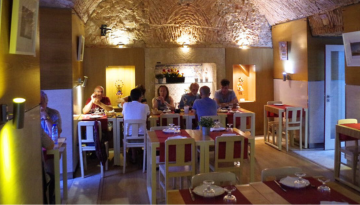 Worth visiting not only for the opportunity to try some of the most iconic petiscos of Alentejo in the relaxed atmosphere of its taberna or to spoil yourself at the more upscale tile-walled restaurant upstairs, but also for the surprisingly stunning neoarab patio, that celebrates Alentejo’s historic connection to the Arab world.
Worth visiting not only for the opportunity to try some of the most iconic petiscos of Alentejo in the relaxed atmosphere of its taberna or to spoil yourself at the more upscale tile-walled restaurant upstairs, but also for the surprisingly stunning neoarab patio, that celebrates Alentejo’s historic connection to the Arab world.
🍴Stop by the taberna and try a variety of Alentejo regional cheeses and cured meats at affordable prices.
📍Rua das Portas de Santo Antão 58, 1150-268 Lisbon
Photo by Bruno R on TripAdvisor
Zé Varunca
 A family owned restaurant, located in the charming Linha de Cascais suburb area of Lisbon, that serves iconic food from Alentejo in very generous portions. A post-meal walk on the seafront is recommended.
A family owned restaurant, located in the charming Linha de Cascais suburb area of Lisbon, that serves iconic food from Alentejo in very generous portions. A post-meal walk on the seafront is recommended.
🍴Don’t miss out on the pézinhos de coentrada, ensopado de borrego or sopa de cação – it doesn’t get much more typically Alentejo than this!
📍Av. Eng. Bonneville Franco 22A, 2770-062 Paço de Arcos
Photo by Time Out Lisboa
Solar dos Nunes
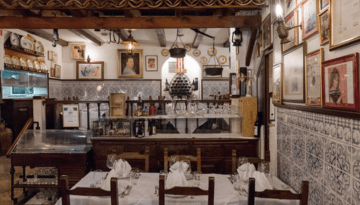 Everything about this restaurant (that consistently appears on the Michelin guide of Portugal) is traditional. From the decor, to the food and ambiance. Famous for its game meat dishes, its uber traditional açordas, and for its dessert pijama, a disappearing restaurant tradition of taking small portions of several desserts, so diners can indulge their sweet tooth without too much damage to their bodies and wallets. Visiting this Alentejan institution in Lisbon is a sure hit.
Everything about this restaurant (that consistently appears on the Michelin guide of Portugal) is traditional. From the decor, to the food and ambiance. Famous for its game meat dishes, its uber traditional açordas, and for its dessert pijama, a disappearing restaurant tradition of taking small portions of several desserts, so diners can indulge their sweet tooth without too much damage to their bodies and wallets. Visiting this Alentejan institution in Lisbon is a sure hit.
🍴Whatever you order as main dish, do end in style with a pijaminha de sobremesas.
📍Rua dos Lusíadas 68, 1300-366 Lisbon
🌐www.instagram.com/solardosnunes
Photo by Lojas Com História
O Galito
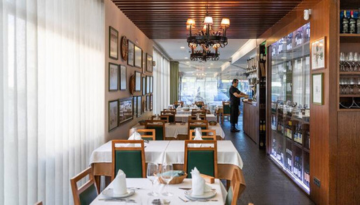 The gaspacho is one of the must try dishes in this restaurant, served with small fried horse mackerel that are supposed to be eaten whole, head and all. The menu is seasonal, so it is possible that some of its dishes won’t always be available for patrons to enjoy. But what is guaranteed is flavor and tradition, as well as its home made traditional Alentejan desserts.
The gaspacho is one of the must try dishes in this restaurant, served with small fried horse mackerel that are supposed to be eaten whole, head and all. The menu is seasonal, so it is possible that some of its dishes won’t always be available for patrons to enjoy. But what is guaranteed is flavor and tradition, as well as its home made traditional Alentejan desserts.
🍴The best dishes to try at O Galito include migas with meat, açorda with salted codfish and the popular gaspacho Alentejano.
📍Rua Adelaide Cabete 7, 1500-441 Lisbon
🌐www.instagram.com/restaurante_o_galito
Photo by Time Out Lisboa
Salsa & Coentros
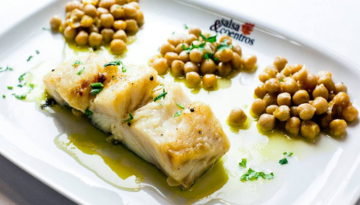 This delightful restaurant unites two of Portugal’s most comforting and robust regional cuisines in one place: Trás-os-Montes and Alentejo. Its migas with potato and eggs (migas de batata e ovo) are famous for a reason!
This delightful restaurant unites two of Portugal’s most comforting and robust regional cuisines in one place: Trás-os-Montes and Alentejo. Its migas with potato and eggs (migas de batata e ovo) are famous for a reason!
🍴The migas de batata e ovo are certainly not to be missed here!
📍Rua Cel. Marques Leitão 12, 1700-337 Lisbon
🌐http://restaurantesalsaecoentros.pt
Photo by Salsa & Coentros on Facebook
Talego
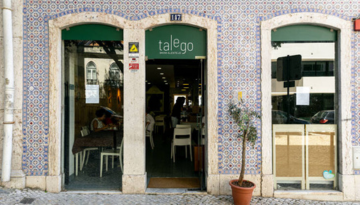 An affordable restaurant that serves only lunches and has a great value for money menu option (which includes a soup, a main, a drink and dessert) and plenty of the big hits of the culinary tradition of Alentejo. The menu changes daily, but it’s always worth a visit, regardless of the dishes of the day.
An affordable restaurant that serves only lunches and has a great value for money menu option (which includes a soup, a main, a drink and dessert) and plenty of the big hits of the culinary tradition of Alentejo. The menu changes daily, but it’s always worth a visit, regardless of the dishes of the day.
🍴Ask about the soup of the day, or try the sopa de cação. If you prefer meat, the ensopado de borrego comes with lots of mint and tastes incredible.
📍Rua Prof. Sousa da Câmara 147, 1070-103 Lisbon
🌐www.instagram.com/restaurante.talego
Photo by Time Out Lisboa
O Magano
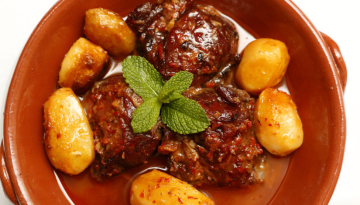 Another classic of the cuisine of Alentejo in the capital, the restaurant owned by the brothers Marco e Bruno Luís serves pure southern Portuguese comfort food, in big portions and big on flavor.
Another classic of the cuisine of Alentejo in the capital, the restaurant owned by the brothers Marco e Bruno Luís serves pure southern Portuguese comfort food, in big portions and big on flavor.
🍴If you’re into petiscos, ask for the salada de orelha, or order something more robust like migas de espargos com entrecosto or the oven roasted goatling (cabrito no forno).
📍Rua Tomás da Anunciação 54A, 1350-328 Lisbon
🌐www.instagram.com/maganorestaurante
Photo by Visão
A Curva
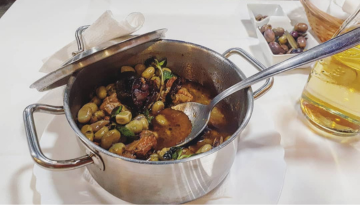 In good Alentejo style, the portions are generous, the service is warm, and the regional cuisine is taken with the respect it deserves, with the focus on the northern part of the region, Alto Alentejo.
In good Alentejo style, the portions are generous, the service is warm, and the regional cuisine is taken with the respect it deserves, with the focus on the northern part of the region, Alto Alentejo.
🍴When in season, ask for the sopa de beldroegas. All year round you can enjoy Iberian black pork cheeks with migas, or a hearty stew of fava beans with short ribs (favas com entrecosto).
📍Av. Conselheiro Ferreira Lobo 28, 2760-030 Caxias
🌐www.facebook.com/restauranteacurva
Photo by Evasões
Taberna do Calhau
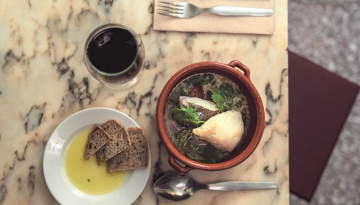 Run by chef Leopoldo Calhau, known to have been leaving a mark on Lisbon’s dining scene, this contemporary tavern in the heart of Lisbon manages to present a modern cuisine, steeped in tradition, in a charming and relaxed atmosphere. Check out their olive oils which you can buy inhouse and take home.
Run by chef Leopoldo Calhau, known to have been leaving a mark on Lisbon’s dining scene, this contemporary tavern in the heart of Lisbon manages to present a modern cuisine, steeped in tradition, in a charming and relaxed atmosphere. Check out their olive oils which you can buy inhouse and take home.
🍴Be open minded (pun intended!) and order some cabeça de xara, that is, head’s cheese.
📍Largo das Olarias 23, 1100-376 Lisbon
🌐www.instagram.com/taberna_do_calhau
Photo by Evasões
The number of restaurants we highlight here is by no means a complete list of establishments from Alentejo in Lisbon. In addition, many restaurants in the capital that are not specifically focused on that region make some Alentejan dishes extremely well. We believe that you’ll definitely be able to taste many local southern Portuguese delights on your trip to Lisbon – after all, it is the biggest city of Portugal, where people from all over the country come to study or work.
Nevertheless, we hope to have sparked your curiosity about not only the culinary traditions but also the culture of this southern land of wide landscapes, charming people, and unique history. Maybe a trip to Alentejo is in order soon, wouldn’t you think?
Until then, we invite you to keep getting inspired about all things travel and food from Portugal, joining Taste of Lisboa’s newsletter, following us on Instagram and tag us @tasteoflisboa or #tasteoflisboa.
Feed your curiosity on Portuguese food culture:
The ultimate guide to olive oil in Portugal
Évora travel guide for food lovers
Portuguese chefs worth the journey from Lisbon – part 2
Day trips from Lisbon that we locals also enjoy
Real people, real food. Come with us to where the locals go.
Signup for our natively curated food & cultural experiences.
Follow us for more at Instagram, Twitter e Youtube
